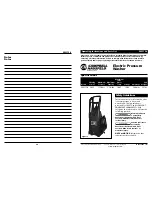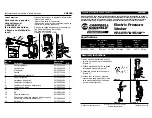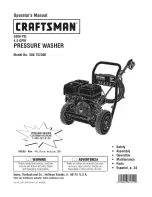
6
ENGLISH
certified electrician and comply with IEC-364.
- It is recommended that the electric supply to
this appliance should include either a residual
current device that will interrupt the supply if
the leakage current to earth exceeds 30 mA for
30 ms.
@
IMPORTANT!
Only use water without any impurities.
If there is a risk of running sands in the inlet water
(i.e. from your own well), an additional filter should
be mounted.
SAFETY DEVICES
The unloader valve can reduce pressure if it
exceeds pre-set values. The spray gun features
a locking device. When the pawl is activated, the
spray gun cannot be operated.
Thermal sensor:
A thermal sensor protects the motor against
overloading. The machine will restart after a few
minutes when the thermal sensor has cooled.
NAME OF PARTS: (FIG. 1 & FIG. 2)
1. On/off switch
2. Wheel
3.Water inlet
4. Gun holder
5.Handle and hose reel
6.Lance holder
7. Water outlet
8. Power cord
9.Detergent bottle holder
10. Gun
11. Detergent bottle
12. Lance
13. Turbo lance
14. Fixed brush
15. Warning label
16. Rating label
PRODUCT DESCRIPTION
PURPOSE
The high pressure cleaner is designed to clean
vehicles, machines, buildings, facades, etc. in
the private sector.
AREAS OF APPLICATION
Never use the machine in potentially explosive
areas under any circumstances!
The operating temperature must be between 0
and +40℃.
The machine consists of an assembly with a
pump, which is encased in a shock absorbing
housing. For an optimal working position the
machine comes with a lance and a non-slip
handle grip, whose shape and configuration
comply with the applicable regulations.
Do not cover or modify the lance or the spray
nozzles in any way.
The high pressure cleaner is designed to be
used with cold or lukewarm (max. 60℃); higher
temperatures can damage the pump.
Do not use water that is dirty, gritty or contains
any chemical products, as these could impair
operation and shorten the life of the machine.
Accessories can be used to carry out work with
foam cleaners, sand spraying.
ASSEMBLY
Position the washer as NEAR as possible to the
water supply.
The washer must be used standing on a secure,
stable, positioned as shown. FIG.3.
Fit the lance into the gun and rotating it until the
two parts are completely locked FIG. 4
Connect the gun to the high pressure hose
FIG.5
Connect the high pressure hose to the water
outlet on the washer FIG.6.
Connect the water supply hose to female
coupler FIG.7, then connect to the water inlet
of the washer. The supply hose must have an
internal diameter of at least 13mm (1/2 in.) and
must be reinforced. The water supply must be
at least equal to the washer delivery capacity.
NOTE: The machine not suitable for
connection to the potable water main (FIG.
14).
@
WARNING
! The intake water temperature must
not exceed 40℃. The water supply must not
exceed 0.7 MPa.
@
CAUTION!
The washer must only be used with
clean water; use of unfiltered water of corrosive
chemicals will damage the washer.
Push the motor switch to “OFF” position FIG.
9.
Check that the electrical supply voltage and
frequency (Volt/Hz) correspond to those
specified on the washer rating plate. If the
power supply if correct, you may now plug in
the washer.
OPERATION
Turn on the water supply tap fully.
Release the safety lock FIG.8, then press the
trigger for a few seconds to allow air to escape








































